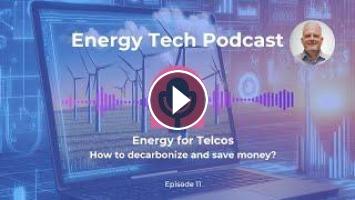Telecommunications companies (telcos) are among the most energy-intensive businesses globally. They account for approximately 2%-3% of the total global energy consumption. Their energy demand is expected to at least triple over the next decade driven by the expansion of network capabilities, growth in data traffic, IoT, and more. Energy is also the second highest operating cost for most telcos (20-40%), right after staff costs.
To combat growing energy demands and expenses, telcos are prioritizing strategies to make their networks more energy-efficient. They're also incorporating renewable energy sources into their operations, which helps them achieve their goal of becoming carbon neutral over time.
And there is some progress. Over the last years the carried traffic per MWh of energy consumed has increased from 12.3 TB (2020) to 15.5 TB (2022), which indicates improvement of network energy efficiency.
Up to 15-30% energy cost savings and decarbonization opportunities
McKinsey & Company suggests a reduction of 15-30% of all energy costs relatively quickly, without major upfront investments! They propose a bundle of operational and organizational measures including state-of-the-art energy management and energy sourcing approaches.[4] These measures imply a virtual power plant concept for telcos ('Telco VPP'), a digital and highly impactful approach.
Is a Telco VPP the solution? New, real-time and digital energy operations
Planning and implementing a Telco VPP presents an innovative opportunity to digitize and manage all energy supply and consumption more efficiently and sustainably. A Telco VPP integrates all energy demand and, if applicable, distributed energy resources (DERs) into a unified digital platform that can be controlled and optimized in real-time (a ‘digital energy twin’).
How do telcos leverage a VPP to manage energy consumption more effectively?
Demand Response: Telcos can pool their energy assets and participate in demand response programs facilitated by the VPP, whereby they adjust their energy consumption in response to signals from grid operators and/or energy wholesale markets. During times of peak demand or grid instability, the VPP can automatically
curtail or shift non-essential energy loads such as cooling systems or non-critical equipment within telco facilities, or
power down base stations during low traffic hours (this can be done without sacrificing performance by using data analytics to predict traffic patterns and identify times when certain parts of the network can be safely powered down).
The objective is to alleviate strain on the electricity grid and earn incentives for load reduction. Telcos can participate in electricity wholesale and grid services markets through the VPP, providing ancillary services such as frequency regulation, voltage support, and capacity reserves. By contributing to grid stability and reliability, telcos can generate additional revenue streams and offset their energy costs, further enhancing the economic viability of their energy management initiatives.
Artificial Intelligence (AI) and Forecasting: AI and forecasting algorithms within the VPP can help telcos anticipate energy demand patterns, renewable generation fluctuations, and market dynamics. By leveraging predictive insights, telcos can proactively adjust their energy management strategies, optimize resource allocation, and minimize energy costs while maximizing the use of renewable energy.
Renewable Energy Integration: Telcos can deploy renewables and storage on their facilities and integrate them into the VPP to generate clean, renewable energy locally. The VPP can optimize the utilization of these renewable resources by prioritizing their use when feasible and supplementing with grid power as needed to meet demand. This not only reduces the telco's carbon footprint but also provides opportunities for cost savings through lower electricity bills and potential revenue from excess energy sales.
Scalability and Flexibility: The modular and scalable nature of VPPs allows telcos to adapt their energy management strategies according to changing business needs, regulatory requirements, and technological advancements. As the telco's energy infrastructure evolves, the VPP can accommodate new DERs, optimize their operation, and continue delivering value in terms of energy efficiency, cost savings, and sustainability.
By leveraging the capabilities of a virtual power plant, telcos can transform their energy management practices, reduce their environmental footprint, and contribute to a more resilient and sustainable energy ecosystem. Through strategic investments in VPP technology and collaboration with energy industry players, telcos can unlock new opportunities for innovation, efficiency, and competitiveness in the rapidly evolving energy landscape.
To combat growing energy demands and expenses, telcos are prioritizing strategies to make their networks more energy-efficient. They're also incorporating renewable energy sources into their operations, which helps them achieve their goal of becoming carbon neutral over time.
And there is some progress. Over the last years the carried traffic per MWh of energy consumed has increased from 12.3 TB (2020) to 15.5 TB (2022), which indicates improvement of network energy efficiency.
Up to 15-30% energy cost savings and decarbonization opportunities
McKinsey & Company suggests a reduction of 15-30% of all energy costs relatively quickly, without major upfront investments! They propose a bundle of operational and organizational measures including state-of-the-art energy management and energy sourcing approaches.[4] These measures imply a virtual power plant concept for telcos ('Telco VPP'), a digital and highly impactful approach.
Is a Telco VPP the solution? New, real-time and digital energy operations
Planning and implementing a Telco VPP presents an innovative opportunity to digitize and manage all energy supply and consumption more efficiently and sustainably. A Telco VPP integrates all energy demand and, if applicable, distributed energy resources (DERs) into a unified digital platform that can be controlled and optimized in real-time (a ‘digital energy twin’).
How do telcos leverage a VPP to manage energy consumption more effectively?
Demand Response: Telcos can pool their energy assets and participate in demand response programs facilitated by the VPP, whereby they adjust their energy consumption in response to signals from grid operators and/or energy wholesale markets. During times of peak demand or grid instability, the VPP can automatically
curtail or shift non-essential energy loads such as cooling systems or non-critical equipment within telco facilities, or
power down base stations during low traffic hours (this can be done without sacrificing performance by using data analytics to predict traffic patterns and identify times when certain parts of the network can be safely powered down).
The objective is to alleviate strain on the electricity grid and earn incentives for load reduction. Telcos can participate in electricity wholesale and grid services markets through the VPP, providing ancillary services such as frequency regulation, voltage support, and capacity reserves. By contributing to grid stability and reliability, telcos can generate additional revenue streams and offset their energy costs, further enhancing the economic viability of their energy management initiatives.
Artificial Intelligence (AI) and Forecasting: AI and forecasting algorithms within the VPP can help telcos anticipate energy demand patterns, renewable generation fluctuations, and market dynamics. By leveraging predictive insights, telcos can proactively adjust their energy management strategies, optimize resource allocation, and minimize energy costs while maximizing the use of renewable energy.
Renewable Energy Integration: Telcos can deploy renewables and storage on their facilities and integrate them into the VPP to generate clean, renewable energy locally. The VPP can optimize the utilization of these renewable resources by prioritizing their use when feasible and supplementing with grid power as needed to meet demand. This not only reduces the telco's carbon footprint but also provides opportunities for cost savings through lower electricity bills and potential revenue from excess energy sales.
Scalability and Flexibility: The modular and scalable nature of VPPs allows telcos to adapt their energy management strategies according to changing business needs, regulatory requirements, and technological advancements. As the telco's energy infrastructure evolves, the VPP can accommodate new DERs, optimize their operation, and continue delivering value in terms of energy efficiency, cost savings, and sustainability.
By leveraging the capabilities of a virtual power plant, telcos can transform their energy management practices, reduce their environmental footprint, and contribute to a more resilient and sustainable energy ecosystem. Through strategic investments in VPP technology and collaboration with energy industry players, telcos can unlock new opportunities for innovation, efficiency, and competitiveness in the rapidly evolving energy landscape.
- Category
- Artificial Intelligence & Business












Comments